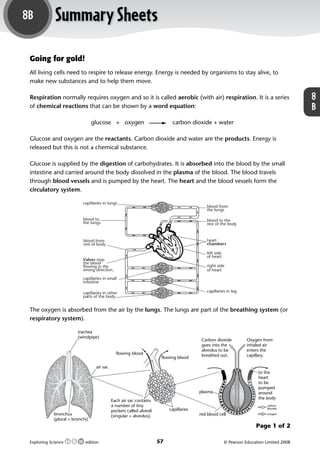More Related Content
Similar to Respiration (20)
More from themassmaker (20)
Respiration
- 1. 8B Summary Sheets
Going for gold!
All living cells need to respire to release energy. Energy is needed by organisms to stay alive, to
make new substances and to help them move.
Respiration normally requires oxygen and so it is called aerobic (with air) respiration. It is a series 8
of chemical reactions that can be shown by a word equation: B
glucose + oxygen carbon dioxide + water
Glucose and oxygen are the reactants. Carbon dioxide and water are the products. Energy is
released but this is not a chemical substance.
Glucose is supplied by the digestion of carbohydrates. It is absorbed into the blood by the small
intestine and carried around the body dissolved in the plasma of the blood. The blood travels
through blood vessels and is pumped by the heart. The heart and the blood vessels form the
circulatory system.
capillaries in lungs
blood from
the lungs
blood to blood to the
the lungs rest of the body
blood from heart
rest of body chambers
left side
of heart
Valves stop
the blood
flowing in the right side
wrong direction. of heart
capillaries in small
intestine
capillaries in other capillaries in leg
parts of the body
The oxygen is absorbed from the air by the lungs. The lungs are part of the breathing system (or
respiratory system).
trachea
(windpipe)
Carbon dioxide Oxygen from
goes into the inhaled air
alveolus to be enters the
flowing blood breathed out. capillary.
flowing blood
air sac
to the
heart
to be
pumped
plasma around
the body
Each air sac contains
a number of tiny carbon
pockets called alveoli capillaries dioxide
bronchus (singular = alveolus). red blood cell oxygen
(plural = bronchi)
Page 1 of 2
Exploring Science edition 57 © Pearson Education Limited 2008
M02_ES_AB_Y8_5415_U8B.indd 57 8/12/09 3:44:30 PM
- 2. 8B Summary Sheets (continued)
The alveoli give the lungs a large surface area so that oxygen can quickly diffuse from the air
inside the lungs into the blood contained in capillaries. The walls of the alveoli and the walls of
the capillaries are only one cell thick, which also makes it easy for oxygen to diffuse into the blood.
The oxygen is then carried by the red blood cells to capillaries around the body.
8 Tissue fluid comes out of other capillaries around the body and bathes the tissues in the body.
B Tissue fluid contains oxygen and glucose. The cells take the oxygen and glucose that they need
from the tissue fluid and put the
carbon dioxide that is produced
back into the tissue fluid. The
tissue fluid soaks back into
ca ,lea en
other capillaries and the carbon
pi ks
.
ry
t o glu g o id,
he se g
f t co xy
lla
ou d in flu
dioxide dissolves in the blood
an arry ue
c iss
T
plasma.
oxygen
Waste products, like and glucose
In the lungs the dissolved carbon dioxide
carbon dioxide diffuses out of dissolve in the
tissue fluid and respiration
the blood and into the air in the go back into
the blood in
lungs. That is why we breathe another capillary.
out (exhale) more carbon
Cells around the body take
dioxide than we breathe in the oxygen and food that they
need from the tissue fluid.
(inhale). The carbon dioxide is
excreted by the lungs. Carbon
dioxide can be tested for by using limewater, which turns from clear to cloudy. Oxygen diffusing
into the blood and carbon dioxide diffusing out of the blood is called gas exchange.
Composition of inhaled and exhaled air.
Inhaled air Exhaled air
nitrogen gas 78% 78%
oxygen gas 21% 16%
carbon dioxide gas 0.03% 4%
water vapour variable more
When you exercise, your breathing rate (number of breaths in one minute) and your pulse rate
(number of heart beats in one minute) increase. This is because your cells need more oxygen and
glucose for respiration.
In some diseases (e.g. emphysema) or when there is little air (e.g. at the top of a mountain) the
body cannot get enough oxygen. People in these situations often feel short of breath and tired. If
too little oxygen gets to cells, the cells cannot release energy from food and so they die.
Most organisms respire using oxygen. Fish and many water organisms have gills to take oxygen
out of the water. Oxygen from the water diffuses into the leaves of underwater plants.
Page 2 of 2
Exploring Science edition 58 © Pearson Education Limited 2008
M02_ES_AB_Y8_5415_U8B.indd 58 8/12/09 3:44:32 PM
